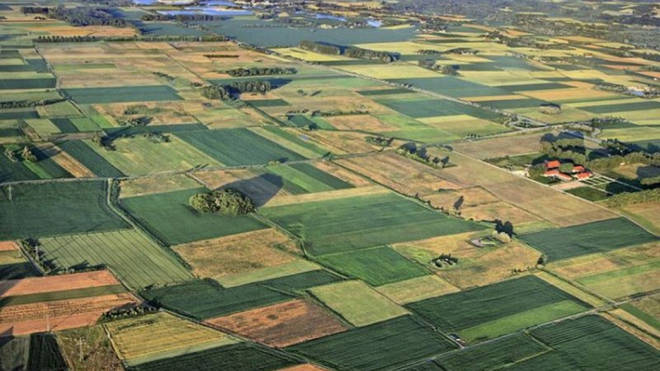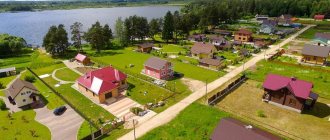For other types of residential development - what does it mean?
On the Rosreestr website there is information about the site. Category: Lands of settlements (land of settlements) Permitted use According to the classifier (code): 142021020400 According to the classifier (description): For other types of residential development According to the document: for housing construction
Found data in the classifier: 142021010000 For individual residential buildings 142021020210 For multi-apartment buildings 142021020210 For low-rise buildings 142021020210 For mid-rise buildings 142021020300 For multi-storey buildings 142021020400 For other types of residential development
Types of permitted use (AUR) on lands of settlements and agricultural purposes
The intended purpose of a land plot is a broad concept that includes a variety of uses. Thus, on the lands of settlements you can build housing, do business, trade, plant gardens, etc. However, not every piece of land within the boundaries of a settlement is suitable for all these types of activities - for example, you cannot build a house near an airport, or open a supermarket within recreation park, a modern cottage may not fit into the historical part of the city, etc.
In this regard, in 2014, by Order of the Ministry of Economic Development No. 540, a classifier of types of permitted use (AUR) of land plots was introduced, which clarified what owners can and cannot do within specific land holdings.
Note: VRI has become one of the criteria for the cadastral value of land. The fewer possibilities for use a site has, the lower its price.
What is the VRI of a site and how to determine it
The VRI of a land plot determines, firstly, the ways of using land property; secondly, the types of buildings that are allowed to be erected on the site.
Types of permits are divided into:
- main types of permitted use;
- conditionally permitted;
- auxiliary.
The easiest way to find out the type of permitted use of a registered land plot is online on the Rosreestr website, using the “Public Cadastral Map” service. In the search field, enter the cadastral number or address of the area of interest. The service provides information about the category of land ownership, its cadastral value, as well as the type of permitted use. All information is taken from the Unified State Real Estate Cadastre (USRN).
Lands of settlements: types of permitted use
Lands of settlements (land of settlements) are used for human habitation. Since the life support needs of the population are diverse, residential buildings have a record-breaking list of permitted uses:
- blocked/multi-apartment/multi-storey buildings;
- individual housing construction (IHC);
- areas for garages;
- land for personal subsidiary plots (LPH);
- use of territories as recreational areas: campsites, tourist centers, sports centers, recreation and entertainment parks, hiking trails and sports tracks;
- plots for business activities: for industrial and municipal facilities, administrative buildings, retail outlets;
- territories for train stations and airports;
- protected natural and cultural sites;
- reserve territories for settlement expansion.
The use of land in settlements is regulated not only by the Land Code, but also by town planning standards, the master plan for the development of the settlement, and the Land Use and Development Rules. Construction on residential lands requires notification or permission from local authorities that the building complies with building regulations.
Owners of plots have the right to change the VRI, if this does not contradict federal legislation and the urban development plan for the territorial zone in which the plot is located. Having learned from the municipality what types of uses are permitted within its zone, the land owner can apply to Rosreestr with an application to change the VRI.
Agricultural land
Agricultural lands are divided into 2 parts according to the types of permitted activities.
- Field plots outside the boundaries of settlements: arable lands, hayfields, pastures, fallow lands - have the form of a permit either for a specific activity (growing crops, grazing livestock, breeding fur animals, etc.) or for the general purpose of “personal subsidiary farming” (LPH). All buildings on these lands must correspond to production needs: greenhouses, cattle pens, sheds for keeping animals, premises for the primary processing of agricultural products - housing cannot be built on these areas. PLEASE NOTE: plots of private household plots can also be located on the lands of settlements (see above); residential buildings can be built on such plots.
- Garden non-profit partnerships (SNT) - unite lands with the type of permitted activity: “for gardening” / “for vegetable gardening”. On garden plots it is possible to build seasonal housing (garden house) with subsequent connection of communications and transfer it to the status of a residential building; lands for vegetable gardens do not have such VRI: it is impossible to build and register housing on them.
Please note: There are also organizations of the DNP form (dacha non-profit partnerships), however, registration of such partnerships was discontinued in 2021.
Conditionally permitted uses
The land owner has the opportunity to expand the permitted use of the site. To do this, you need to contact the local government with a request to grant it a conditionally permitted type of use of the site. This type of additional permit is not provided for by the classifier that regulates land use throughout the country. However, the municipality, based on the realities of the development of a separate settlement, can give the go-ahead to the initiatives of land plot owners. Examples of a conditionally permitted type of use of a plot of land include:
- construction of a residential building exceeding the parameters of individual housing construction;
- organization of a retail trade point on the site;
- construction of a gym, swimming pool;
- construction of an office, clinic, veterinary hospital, etc.
An example of granting permission for a conditionally permitted type of use:

The local administration organizes a public discussion at the request of the owner - a prerequisite for deciding on the conditionally permitted type of use of the site. Next, an examination is carried out and a conclusion is made about the possibility of such use or whether it contradicts legal norms. The municipality notifies Rosreestr of a positive resolution of the issue, which makes changes to the characteristics of this site.
Auxiliary permitted uses
A necessary addition to the types of activities that are permitted on the site are auxiliary types of permitted use. For example, for public services for housing or a workshop on the site, a transformer booth is needed, and for visitors - an equipped parking lot or a public toilet. The construction of these and other small facilities is classified as ancillary uses. They are in the nature of clarifications, provided that the land plot is used for its intended purpose and the owner of the land does not violate the scope of the main type of permitted activity.
Public lands
In any category of land there are public areas - places of free access for all citizens. A beach on the shore of a reservoir, an ecological trail in a reserve, a field road between agricultural lands, fire reservoirs in SNT, squares and boulevards of cities - these lands are owned by the state and are not subject to purchase and sale. Organizations can lease such territories, and individuals can use them free of charge. In accordance with urban planning regulations, permanent and temporary buildings can be erected on public lands: offices, retail outlets, beach infrastructure. After registering the ownership of buildings, you can make any transactions with them - the land under the objects passes to the new owner under the rights of assignment of lease rights.
Seizure of public lands is punishable by a fine of up to 2 thousand rubles for individuals, and up to 20 thousand for legal entities. If illegal buildings have appeared on the lands, they are subject to demolition at the expense of the violator.
Is it possible to build a house on a site with permitted use for other types of residential development?
Placement of a residential building not intended to be divided into apartments (houses suitable for permanent residence and no higher than three above-ground floors); agricultural production; placement of a garage and other auxiliary structures; keeping farm animals
Placement of a residential building, not intended for division into apartments, having one or more common walls with neighboring residential buildings (the number of floors is no more than three, with a total number of combined houses no more than ten and each of which is intended for one family, has a common wall (common walls) without openings with the neighboring block or neighboring blocks, located on a separate plot of land and has access to a common area (blocked residential buildings); cultivation of ornamental and fruit trees, vegetable and berry crops; placement of individual garages and other auxiliary structures ; arrangement of sports and children's playgrounds, recreation areas
Is it possible to build a house on land for gardening?
Have you decided to move from a noisy city to a quiet town? Do you own a plot of land intended for gardening?
Based on Article 40 of the Land Code of the Russian Federation and Article 263 of the Civil Code of the Russian Federation, the owner of the territory has the legal right to develop the land belonging to him at his own discretion.
To answer unambiguously whether it is possible to build residential buildings on land for gardening, it is necessary to determine the category of the site.
Thus, if this object is located on territory intended for agricultural purposes, the construction of a private house for permanent residence and subsequent registration is prohibited. The solution in this situation would be to change the purpose of the land.
The owner of the territory can build a garden house, providing it over time with the communications necessary to recognize the premises as residential (heating, running water, electricity, etc.).
A building can be officially transferred from non-residential to residential status by contacting the local administration.
If a private house is built on land within the boundaries of a populated area with the type of permitted use “for gardening,” the law is not formally violated.
Maintenance of residential buildings
5. Public and business zones are intended for the placement of healthcare facilities, culture, trade, public catering, social and municipal purposes, business activities, secondary vocational and higher education facilities, administrative, research institutions, religious buildings, parking lots, objects for business, financial purposes, and other objects related to ensuring the livelihoods of citizens.
As a result of urban planning zoning, residential, public and business, industrial zones, zones of engineering and transport infrastructures, zones of agricultural use, recreational zones, zones of specially protected territories, special purpose zones, zones of military installations and other types of territorial zones can be determined.
What does Permitted Use mean: For other types of residential development
In this case, we are talking about permissible types of use of the land. In your case, it is simply not specified what specific type of development this site can be used for. It is difficult to say for sure without seeing complete information on the land plot. Therefore, I advise you to independently clarify information about specific types of use (taking into account special marks) in any branch of Rosreestr, or at the office. website of this department.
We recommend reading: Dixie Rogovo alcohol sales
Hello! It is difficult to determine anything from online information. In addition, there may be outdated or erroneous information. You need to order a cadastral passport of the land plot, it will be visible there. If it contains codes 2.0-2.7 then this is what you need
What does it mean for other types of residential development?
It is this document that gives the right to construct or reconstruct a building site and carry out major repairs. A building permit certifies the legality of the planning scheme with the location of the building. In the process of preparing a permit, it is possible to identify various controversial issues and eliminate them and, thereby, avoid further difficulties in subsequent approvals of the necessary project documentation, strictly following the requirements of the legal procedure for the construction of the facility and its timely commissioning.
To answer these questions, you will have to turn to the Town Planning Code of the Russian Federation, to its article 49, paragraph 2 of which states that residential buildings of blocked residential development are understood to be residential buildings that meet the following requirements: Thus, in relation to a land plot, it is said that each block must have its own plot, and the block itself must have its own isolated access to the public territory.
Conditionally permitted types of land use in 2021
The main difference between a conditional type of use is that in order to assign it to an object, additional approval is required from the government authority. The main VRI is appointed for the allotment immediately, without additional applications and commission hearings.
For example, a retail facility with an area of two hundred square meters may have the following conditional types of purpose:
- Administrative institution.
- Office space.
- Trade pavilion.
- Utility room.
- Stock.
This type of premises can also be used for hospitals, gyms or swimming pools.
For an allotment in rural areas, in addition to the main one (LPH), conditional types of exploitation can be:
- Breeding large and small livestock.
- Poultry farming.
- Cultivation of a garden and vegetable garden.
- Floriculture.
In this case, plots are divided into household plots and field plots. In the first case, it is allowed to build cottages, country houses, and garages. Any buildings with a foundation are prohibited in the field.
What does it mean for other types of residential development?
Thus, federal legislation separates the concepts of “development zones for individual residential buildings” and “residential development zones of other types.” According to the Classifier of types of permitted use of land plots, approved by order of the Ministry of Economic Development of Russia dated September 1, the Classifier also stipulates that the list of types of permitted use of land plots includes land plots intended for individual housing construction with the placement of an individual residential building on it suitable for permanent residence , no higher than three above-ground floors, as well as land plots intended for personal subsidiary farming, gardening, summer cottage farming with the placement of a residential building on them, not intended for division into apartments.
The Classifier of permitted types of activities on land plots developed by the Ministry of Economic Development made it possible to streamline the current situation with the types of their use. Types of permitted use of VRI land plots and the possibility of constructing certain objects on them will now be determined only in accordance with the Classifier, and types of use of land plots not provided for by the Classifier will not be included in the state real estate cadastre.
Agricultural land
Use of agricultural land
regulated by Law No. 101-FZ of July 24, 2002 “On the turnover of agricultural land”; Land Code of the Russian Federation, Law No. 66-FZ of April 15, 1998 “On horticultural, gardening and dacha non-profit associations of citizens”, Law No. 74-FZ of June 11, 2003 “On peasant (farming) farming” and other regulations .
Land plots covered by Law No. 101-FZ are not intended for housing or other construction not related to agricultural production. If such a plot of land is not used for its intended purpose within three years (the field is not sown, not mowed, construction is underway), then an administrative fine in the amount of 3 thousand rubles is provided for this. It is not recommended to build houses on land plots occupied by farmland (arable land, hayfields, pastures, perennial plantings).
Such land plots are intended for crop production, animal husbandry, scientific support of agriculture, storage and processing of agricultural products, private farming on field plots, creation of nurseries, and provision of agricultural production. Even such type of permitted use as “running personal subsidiary plots on field plots” provides for the use of land for the production of agricultural products without the right to capital construction of facilities.
Land plots allocated for garage construction, personal subsidiary farming (LPH), dacha farming, gardening, livestock farming, gardening, as well as land plots occupied by buildings, structures, structures, are used in accordance with the types of permitted use established for them (Article 12 Law No. 66-FZ). The construction of houses is permitted on the following agricultural land plots: for running personal subsidiary plots (with the right to build), for running summer cottages and gardening.
A special category consists of lands allocated for peasant (farm) farming.
. They can be used for the construction of buildings and structures necessary for the farmer’s permanent residence on the site and his economic activities. This type of permitted use is good for building work on large estates and estates, the size limits of which are set by the local authority.
What does this mean for individual residential development?
In accordance with the Resolution of the Council of Ministers - Government of the Russian Federation dated June 20, 1993 N 595 “On the State Target Program “Housing””, the main direction of structural changes in architecture and urban planning is
This article examines in more detail one of them - the object of legal relations arising in connection with the construction of individual residential buildings. The term “individual housing construction” is used very often in by-laws of the Soviet period. It is often used now, including in the laws of the Russian Federation. The term “low-rise housing construction” is used quite often.
Other types of residential development
1. What does the USR mean in special marks. Information about the types of permitted use, areas have the status (current uncertified) the right (restriction of the right, encumbrance of the property) is registered for this property with the types of permitted use (for other types of residential development) with an area of 1458 sq.m. the information necessary to fill out section 4 is missing. The information required to fill out section 4.2 is missing.
Land category: Lands of populated areas. Form of ownership: Private property. Specified area: 416 sq. m. Permitted use: For other types of residential development according to the document: For maintenance of a residential building.
What purpose can a building be built on a land plot with VRI “public services”?
The PZZ for the type of permitted use “public services” provides for the placement of capital construction facilities in order to provide the population and organizations with public services, in particular:
parking lots, garages and workshops for servicing cleaning and emergency equipment,
as well as buildings or premises intended for receiving the population and organizations in connection with the provision of public services to them.
What purpose can a building be erected on such a plot of land by a private individual (not a municipality or institution)?
Thank you for your attention to the issue!
Lawyers' answers (1)
In fact, the answer to your question is contained in the question itself. Additionally, I provide an excerpt from the order of the Ministry of Economic Development: Placement of capital construction projects in order to provide the population and organizations with public services, in particular: supply of water, heat, electricity, gas, provision of communication services, drainage of sewage, cleaning and cleaning of real estate (boiler houses, water intakes , wastewater treatment plants, pumping stations, water pipelines, power lines, transformer substations, gas pipelines, communication lines, telephone exchanges, sewers, parking lots, garages and workshops for servicing cleaning and emergency equipment, waste incineration and waste processing plants, landfills for disposal and sorting of household waste and waste, places for collecting things for recycling, as well as buildings or premises intended for receiving the population and organizations in connection with the provision of public services to them). In addition, I would like to draw your attention to the fact that in addition to the main types of use, the PPL specifies auxiliary uses. The most important question is what is your goal, what do you want to build. Based on a clear goal, it is necessary to analyze whether something can be brought under it.
This is the main type, auxiliary ones are not suitable.
The goal is to acquire ownership of a plot of land, and this can be done by building something on it.
Everything that is directly related to public services - sewers, structures, substations - is all the prerogative of municipal unitary enterprises and the municipality, or if the power grid, then private companies; if for the maintenance of apartment buildings, then there are management companies, homeowners' associations and residents.
The most acceptable are garages and workshops for servicing equipment and buildings for receiving individuals/legal entities
Classifier of types of permitted use of land plots (VRI)
- Identification documents of the applicant. If there are several owners, then the passports of all;
- Power of attorney, if one of the owners acts through a proxy;
- Notarized consent to change the purpose of the site;
- Cadastral documentation for the site (passport and plan);
- Extract from the real estate register;
- The document on the basis of which land ownership is carried out (lease, deed of sale, deed of gift, etc.);
- Statement.
The law does not provide a clear interpretation of the permitted use of land. Therefore, the concept is derived from an analysis of existing legal provisions. The permitted use of a land plot is a characteristic of the land based on the zoning of the territory for its intended purpose. In other words, the type of permitted use determines the functional purpose of the territory. For example, for the construction of high-rise buildings.
Conditionally permitted type of land plot: procedure for assignment or change
In order to change or assign a new condition for the use of a land plot, it is necessary to go through the permit and registration procedure (regulated by the Town Planning Code of the Russian Federation):
- It is necessary to collect a complete package of documents confirming ownership of the property.
- With the collected package, contact the local administration and write an application.
- Administration officials organize a commission and public hearings on the case.
- Based on them, a conclusion is made - the applicant is given consent or refusal to provide a conditionally permitted VRI.
- If the decision is positive, the administration sends the information to the Cadastral Chamber, where it is recorded and entered into the Rosreestr.
- After this, the owner can receive a modified EGRN extract and use the land for its intended purpose.
An example would be the conversion of agricultural land into land for residential construction.
Loading…
Too long?
Reload document
| Open in new tab
Permitted use for other types of residential development
I was pleased with this company. Read reviews and learn more about the company's reputation. When purchasing and selling an apartment on the secondary market, you will need to present a document confirming the estimated value of the property being purchased.
The application was changed on April 8. The content of this type of permitted use includes the content of types of permitted use with codes 1. Carrying out economic activities related to the cultivation of agricultural crops. Growing grains and other agricultural crops. Carrying out economic activities on agricultural land related to the production of grains, legumes, feed, industrial, oilseeds, essential oils, and other agricultural crops. Carrying out economic activities on agricultural land related to the production of potatoes, leafy, fruit, bulbous and melon crops, including the use of greenhouses. Growing tonic, medicinal, flower crops.
We recommend reading: What are the contributions when withholding for unworked personal income tax vacation days 2021
Land categories
Concepts such as “category of land” and “type of permitted use” are defined in government regulations. In the Land Code, the entire composition of Russian lands according to their intended purpose is divided into 7 categories. Each category of land has legally established characteristics and a legal regime of use.
| Land category | Share in the Land Fund of the Russian Federation |
| Forest fund | 65,6% |
| Agricultural land | 22,6% |
| Reserve Fund | 5,2% |
| Specially protected areas | 2,7% |
| Water fund | 1,6% |
| Lands of settlements (settlements) | 1,2% |
| Industrial and other purposes | 1% |

Only two categories are traded on the real estate market: land in populated areas and agricultural land - they can be purchased and disposed of (only within the framework of the intended use of the land plot). These lands will be discussed below, but for now we will briefly consider other categories of lands. They are excluded from free circulation and are entirely at the disposal of the state. However, lease/concession of plots is allowed on their territory.
- Forest Fund. Within its territories, zones with permitted deforestation and areas for afforestation are allocated - their use is regulated by the Forest Code.
- Water fund. The legal regime for the use of reservoirs and coastal strips is regulated by two codes - Land and Water. Activities such as the construction of hydraulic structures, general and special use of reservoirs are permitted here.
- Specially protected natural areas (SPNA). The lands of protected areas are state or municipal property, within their boundaries it is possible to conduct scientific research and develop ecotourism. Economic activity on the territory of reserves, wildlife sanctuaries, natural parks and arboretums is prohibited by law.
- Industrial lands. Territories occupied by industrial facilities and transport infrastructure have a protective sanitary zone, within which settlement and economic activity of people is prohibited. These lands are not subject to transfer to other categories, unless industrial activity on them ceases and reclamation work begins.
- Reserve fund. Territories not yet involved in economic turnover are the property of the state/municipality. There is no legal regime for use on them, and economic activity is not permitted.
It is possible to transfer a land plot from one category to another. For example, you want to purchase a plot on the outskirts of a village for construction, but it is included in the category of reserve (reserve) land. It is necessary to contact the competent local/federal authority with an application. If there are no contradictions with the law, the application can be granted, appropriate changes will be made in the State Register - the site will become a settlement or agricultural land. Then it can be purchased and used for construction, agricultural or other permitted activities.

What does it mean for residential buildings
Having derived a precise definition, it is possible to clarify what a complex of interlocked residential buildings is. Blocked development houses are a type of residential building in the form of an apartment building, where each apartment has its own exit to the street. This is the main difference between the house and country cottages or small mansions. Such block buildings, like any other houses, have both advantages and disadvantages. According to paragraph N, the explanation of the legislation of the Russian Federation, the practice of its application, as well as the interpretation of norms, terms and concepts are carried out by federal executive authorities in cases where they are assigned the corresponding responsibility.
Certain difficulties are caused by the consequences of the introduction of the Classifier, associated, for example, with obtaining permission to build residential buildings on plots for peasant farming - due to the absence of this type of use in the list of the new Classifier.
Article 35


In this sense, it is worth agreeing with the opinion of some researchers that “today, detailed regulation of the institution of urban zoning in domestic legislation, aimed at regulating the use and protection of land within the boundaries of settlements, is beginning to be used in a complementary manner to establish the legal regime of lands of other categories. This trend indicates that in the provisions of Part 2 of Art. 7 of the Land Code of the Russian Federation, which establishes that the legal regime of lands is determined based on their belonging to one or another category and permitted use in accordance with the zoning of territories, the “center of gravity” of legal significance is gradually moving. The main criterion for the legal regime of a specific land plot is the permitted use, which is established in accordance with urban planning regulations, which are a basic element of the institution of zoning of territories.” ——————————— Morgunova E.R. Urban planning zoning and its influence on the establishment of the legal regime of land // Legal World. 2021. N 11.
General provisions on land use
Misuse of plots is prohibited by law. The permitted method is indicated in the documentation for the land: Cadastral passport and Certificate of ownership. If the land according to the papers is intended for residential development and subsidiary farming, industrial and administrative buildings cannot be built on it.
If the owner intends to change the nature of land use, to obtain permission it is necessary to contact the appropriate service and amend the allotment passport. If it is impossible to change the method of using the territory, you will have to sell the current one and purchase a new one.
The main document that guides government agencies in this regard is the urban planning plan - it indicates the goals and plans for the development of territories in a city or rural settlement. At the municipal level, rules for development and land use are established. They are based not only on the Land Code of the Russian Federation, but also on the economy and climate of the region.
They define:
- General directions of development of the region.
- Breakdown into zones (for residential construction, manufacturing, infrastructure, agriculture, etc.) with a description of the functionality and prohibitions for each.
- List of environmental protection measures.
- Borders of settlements.
Thanks to a clear division of the general territory into industrial, residential, administrative, agricultural, forest, environmental and other zones, it is possible to achieve order and the most rational use of land - conditionally permitted uses depend on them. The most commonly used functional zone is an area near a populated area.

Land issues
Settlement lands include land plots within the boundaries of cities, urban-type settlements and rural settlements, and occasionally enclave territories. The basis for transferring the lands of settlements to another category is a change in the boundaries of settlements. Since PZZs are adopted by local authorities for each locality separately, it cannot be said unequivocally that the construction of a residential building is possible only in a residential development zone.
In addition to the categories of intended use, Russia also has territorial zoning standards, for example, zones of residential or public and business development within the lands of settlements, zones of agricultural land as part of agricultural lands. As a rule, land plots can be assigned to only one territorial zone. For each settlement, territorial zones are established by land use and development rules (LRU). The PZZ includes an urban zoning map and urban planning regulations .
All types of land on which you can build a house in 2021.
So, let’s list the types of permitted use of land plots on which you can build a house, ranking them in order from the most profitable (priority) to the least desirable.
Having built a house on a plot for individual housing construction,
you can get a registration (have a postal address); income tax deduction; if necessary, provide the house to the bank as collateral; benefit from nearby communications, landscaped surrounding areas and developed social infrastructure; Use a mortgage loan for construction. Disadvantages: the need to obtain a building permit and restrictions on the size of the house. So, we list the types of permitted use of land plots on which you can build a house, ranking them in order from the most profitable (priority) to the least desirable.
Legal regime for the construction of a house on a private plot of private household plots,
if it is located within a populated area (urban or rural), it is no different from a house on a plot for individual housing construction. You can register in it, and large areas of land can be used for agricultural production. However, construction is not permitted on all private plots (outside the populated area, construction on such lands is prohibited).
When building a house on land for dacha farming or gardening
no need to obtain a building permit. But today it is possible to register in a country house or garden house only through a judicial procedure.
Blocked residential development
– type of permitted use of land plots, typical for populated areas. But at the same time, you do not get a separate residential building, but a building that has common walls with neighboring houses.
When building a house or estate on a plot of land provided for K(F)H,
A prerequisite is to conduct farming activities and provide tax reporting. Registration in such a house is possible only through the court.
List of sources used:
- Land Code of the Russian Federation (Land Code of the Russian Federation) dated October 25, 2001 No. 136-FZ (current edition dated March 8, 2015). – Access mode: https://www.consultant.ru/popular/earth/.
- On horticultural, gardening and dacha non-profit associations of citizens / Federal Law of 15.04. 1998 N 66-FZ (as amended on December 31, 2014). – Access mode: https://www.consultant.ru/document/cons_doc_LAW_173607/.
- On the turnover of agricultural land / Federal Law No. 101-FZ of July 24, 2002 - https://www.consultant.ru/document/cons_doc_LAW_37816/.
- On peasant farming / Federal Law of June 11, 2003 No. 74-FZ. — https://www.consultant.ru/document/cons_doc_LAW_168304/#p30.
All lands in our country have a certain category. In this regard, a specific site can be used only within the framework specified by law.
The use of an object for other purposes and the erection of a structure on it that is not intended for the same purpose as the category of land is unacceptable.
Quite a lot of owners are interested in whether it is possible to build a house used for regular living on gardening land?
Not all plots allocated to citizens for gardening are allowed to build residential buildings.
The main purpose of constructing such a premises is subsequent living in it. However, obtaining permission to register in a private house is sometimes problematic.
Plots intended for gardening most often belong to the agricultural category of land, but may be part of settlement land. This information determines whether it will be possible to build a residential building on this territory.
On such a territory, according to the classifier of types of permitted use of sites, it is allowed to erect buildings for economic purposes:
- sheds;
- baths;
- greenhouses;
- garage;
- garden house for recreation (not intended for permanent residence);
- other utility buildings used for growing crops.
Formally, the law does not prohibit construction on lands allocated for gardening, but not every building is allowed to be erected.








